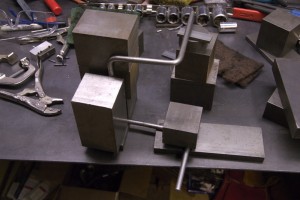Doing this kind of work, lots of times there just isn’t “the way that it’s done.” Sure, there might be “a” way that it’s done, but not “the” way. And lots of times a way that worked before won’t work again, because something else is different, like now you’re against a wall whereas before you had plenty of space behind the thing, or before you had plenty of running room following the thing you want to do, but this time you only have, say, three inches, and the ball will be going much to fast to make that happen, whatever “that” or anything else may be.
I’m sure you get my point. Lots of times I take photos for my own remembrance of things…although cataloging them would probably be an excellent idea. Well, never mind that for now, at least many of them are showing up here. Matthew Gaulden and Vic Chaney both mentioned specifically that it’s important to write down how you figured out a way to solve a problem, because lots of times you come across that same problem again, but you can’t remember how you solved it the first time!
Here’s a common problem: holding a couple things together so they can be welded. I solved it in a rather unstupendous but quick and easily repeatable way. I used a bunch of my steel blocks (again I say “YES” to my wonderful habit of picking these things up on instinct whenever I run across one) and just stacked them all up so they would hold these two pieces of solid bent rod in alignment long enough for me to tack weld them.
It’s really hard to see (I congratulate myself on making a very close joint!), but look at the small stretch of rod that is closest to the table’s surface and positioned between the two sets of blocks. If you look closely you can see the parting line where those two pieces have yet to be welded. It turned realllllly nicely, I am very happy to say. That doesn’t always happen. It worked, though, and this thing now holds up a couple of different pieces of the sculpture, including two loops from the loop-the-loop section. It holds up some neater stuff that I’ll show a bit later. Until then, best of luck in your creative pursuits.


As Heraclitus posited, “you can’t step in the same stream twice.” I think that pertains to creative pursuits as well. You try to replicate something as you’ve done it before, but so many new and unconsidered variables confound the replication process. Flexible and unorthodox problem-solving and correction are needed. You, my dear friend Tom, have that in spades.
Sitting here at work, thinking about you Tom. I hadn’t looked at your site in a long time and figured I’d spend time perusing. Also, Max is taking up the harp. I may have him bend your ear for pointers.